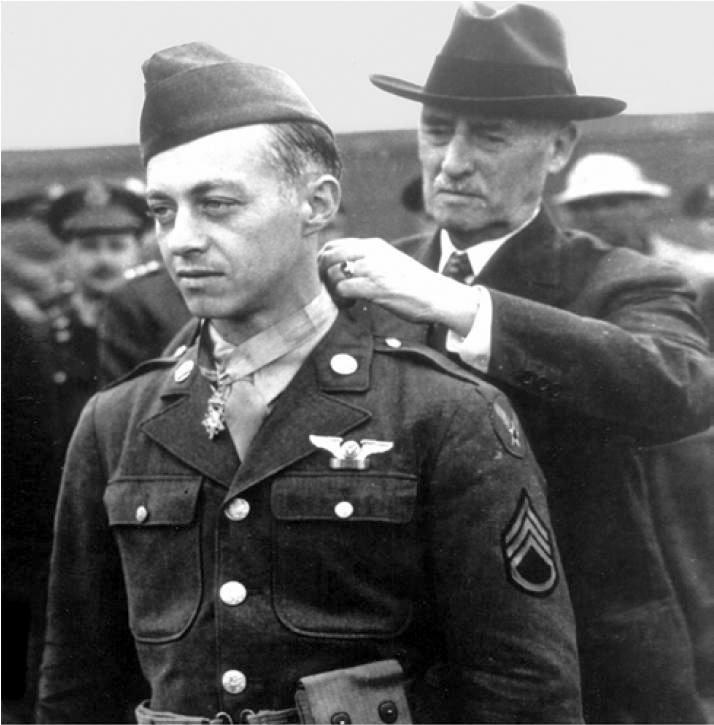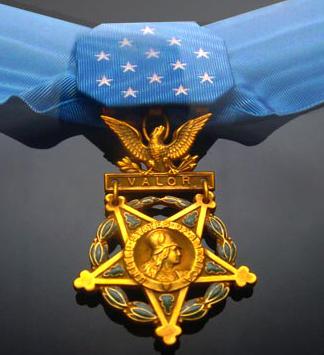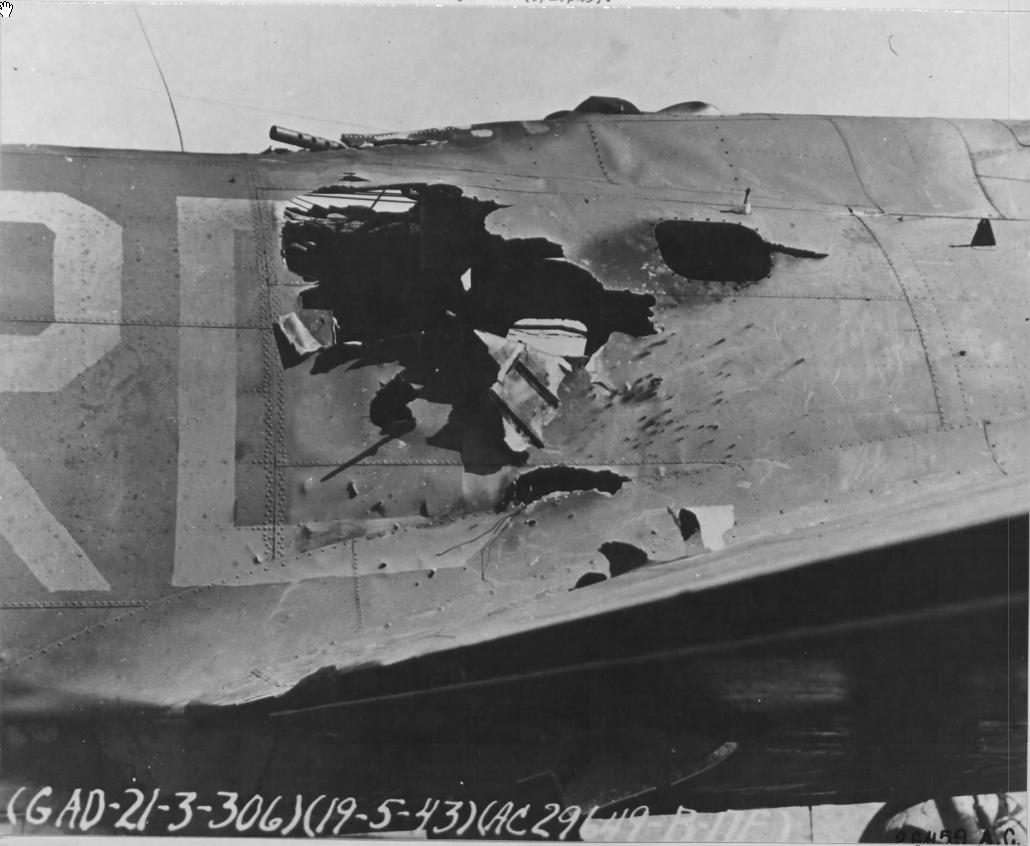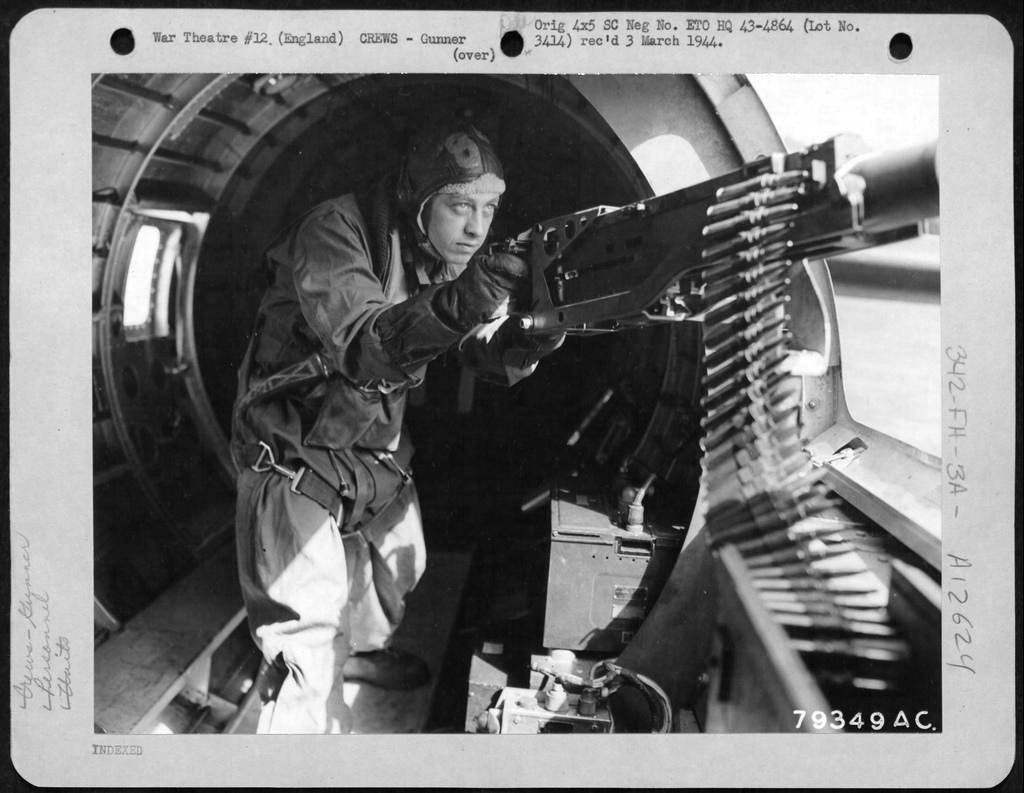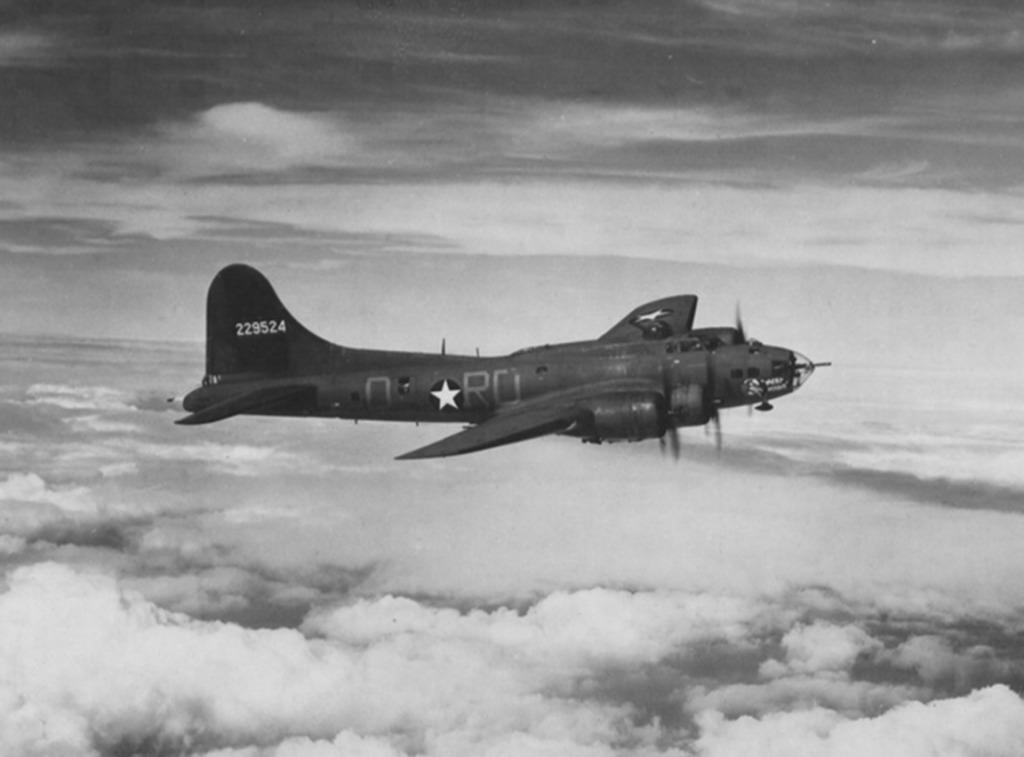|
Look carefully at the B-17
and note how shot up it is - one engine dead, tail, horizontal stabilizer and
nose shot up. It was ready to fall out of the sky. Then realize that there is a
German ME-109 fighter flying next to it. Now read the story below. I think
you'll be surprised.
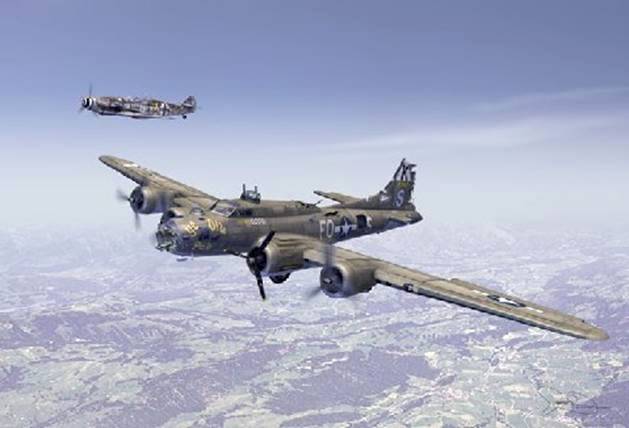
Charles Brown was a B-17
Flying Fortress pilot with the 379th Bomber Group at Kimbolton, England. His
B-17 was called 'Ye Old Pub' and was in a terrible state, having been hit by
flak and fighters. The compass was damaged and they were flying deeper over
enemy territory instead of heading home to Kimbolton.
After flying over an enemy
airfield, a German pilot named Franz Steigler was ordered to take off and shoot
down the B-17. When he got near the B-17, he could not believe his eyes. In his
words, he 'had never seen a plane in such a bad state'. The tail and rear
section was severely damaged, and the tail gunner wounded. The top gunner was
all over the top of the fuselage! The nose was smashed and there were holes
everywhere.
Despite having ammunition,
Franz flew to the side of the B-17 and looked at Charlie Brown, the pilot. Brown
was scared and struggling to control his damaged and blood-stained plane.
Aware that they had no idea
where they were going, Franz waved at Charles to turn 180 degrees. Franz
escorted and guided the stricken plane to, and slightly over, the North Sea
towards England. He then saluted Charles Brown and turned away, back to Europe!
When Franz landed he told
the CO that the plane had been shot down over the sea, and never told the truth
to anybody. Charles Brown and the remains of his crew told all at their
briefing, but were ordered never to talk about it.
More than 40 years later,
Charles Brown wanted to find the Luftwaffe pilot who saved the crew. After years
of research, Franz was found. He had never talked about the incident, not even
at post-war reunions.
They met in the USA at a
379th Bomber Group reunion, together with 25 people who are alive now - all
because Franz never fired his guns that day.
Research shows that Charles
Brown lived in Seattle and Franz Steigler had moved to Vancouver, B.C. Canada
after the war. When they finally met, they discovered they had lived less than
200 miles apart for the past 50 years!
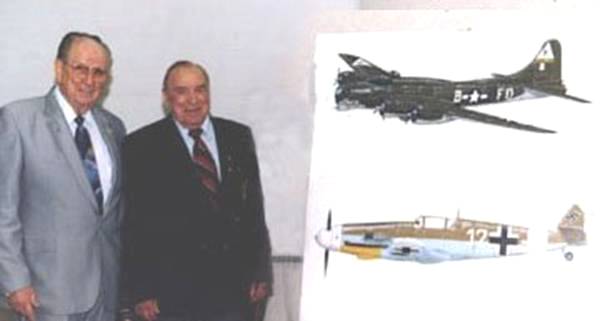
Another B17 Story
http://www.youtube.com/watch?v=_OAPgo1iUvM&feature=youtu.be
(copied with permission)
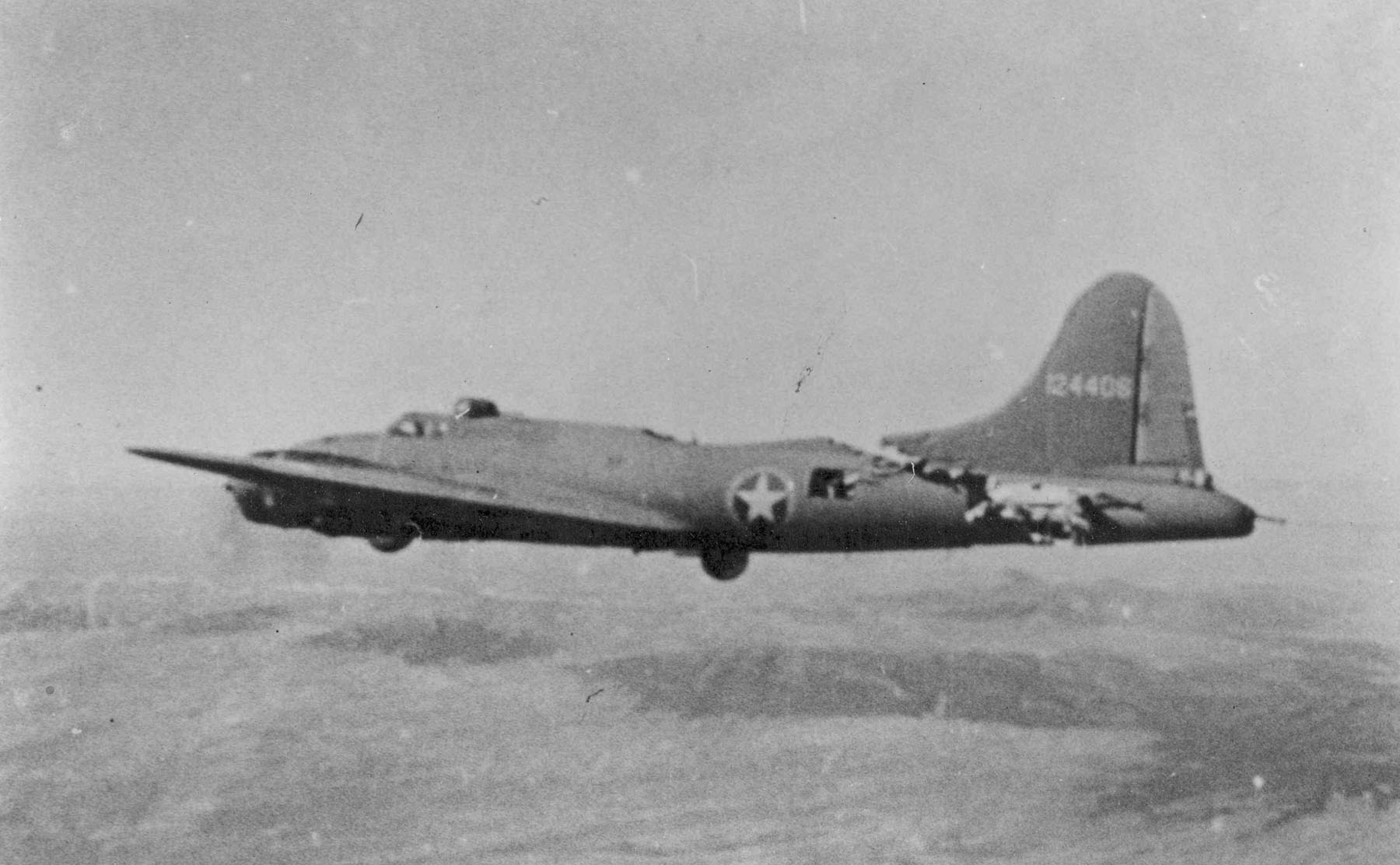
Flying back over the desert to its base in Biskra, Algeria.
|
A mid-air collision on 1FEB1943 between a
B-17 and a German fighter over the Tunis dock area became the subject of
some of the most famous photographs of World War II.
An enemy fighter attacking a 97th Bomb Group formation
went out of control, probably with a wounded pilot, then continued its
crashing descent into the rear of the fuselage of a Fortress named All
American, piloted by Lt. Kendrick R. Bragg, of the 414th Bomb Squadron.
When it struck, the fighter broke apart, but left some pieces in the
B-17. The left horizontal stabilizer and elevator of the Fortress were
completely torn away.
The two right engines were out and one on the left had a serious oil
pump leak. The vertical fin and the rudder had been damaged, the
fuselage had been cut almost completely through – connected only at two
small parts of the frame and the radios, electrical and oxygen systems
were damaged. There was also a hole in the top that was over 16 feet
long and 4 feet wide at its widest and the split in the fuselage went
all the way to the top gunner’s turret. Although the tail actually
bounced and swayed in the wind and twisted when the plane turned and all
the control cables were severed , except one single elevator cable still
worked, and the aircraft still flew-miraculously!
The tail gunner was trapped because there was no floor connecting the
tail to the rest of the plane. The waist and tail gunners used parts of
the German fighter and their own parachute harnesses in an attempt to
keep the tail from ripping off and the two sides of the fuselage from
splitting apart. While the crew was trying to keep the bomber from
coming apart, the pilot continued on his bomb run and released his bombs
over the target.
When the bomb bay doors were opened, the wind turbulence was so great that
it blew one of the waist gunners into the broken tail section. It took
several minutes and four crew members to pass him ropes from parachutes
and haul him back into the forward part of the plane. When they tried
to do the same for the tail gunner, the tail began flapping so hard that
it began to break off. The weight of the gunner was adding some
stability to the tail section, so he went back to his position.
The turn back toward Biskra, Algeria, had to be very slow to
keep the tail from twisting off. They actually covered almost 70
miles to make the turn home. The bomber was so badly damaged that it
was losing altitude and speed and was soon alone in the sky.
For a brief time, two more Me109
German fighters attacked the All American. Despite the extensive
damage, all of the machine gunners were able to respond to these
attacks and soon drove off the fighters. The two waist gunners stood
up with their heads sticking out through the hole in the top of the
fuselage to aim and fire their machine guns. The tail gunner had to
shoot in short bursts because the recoil was actually causing the
plane to turn.
Allied P51 fighters intercepted the All American and took one of the pictures shown below. They also
radioed to the base describing the empennage was “waving like a fish
tail” and that the plane would not make it and to send out boats to
rescue the crew when they bailed out. The fighters stayed with the
Fortress taking hand signals from Lt. Bragg and relaying them to
the base. Lt. Bragg signalled that 5 parachutes and the spare had
been "used" so five of the crew could not bail out.
He made the decision that if they could not bail out safely, then he
would stay with the plane and land it. Two and a half hours after
being hit, the aircraft made its final turn to line up with the runway
while it was still over 40 miles away. It descended into an emergency
landing and a normal roll-out on its landing gear. When the ambulance
pulled alongside, it was waved off because not a single member of the
crew had been injured.
No one could believe that the aircraft could still fly in such a
condition. The Fortress sat placidly until the crew all exited through
the door in the fuselage and the tail gunner had climbed down a
ladder,
at which time the entire rear section of the aircraft collapsed onto
the ground.
The rugged old bird had done its job.
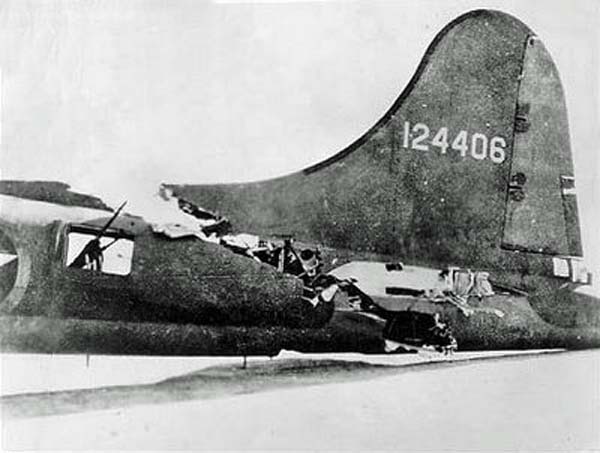
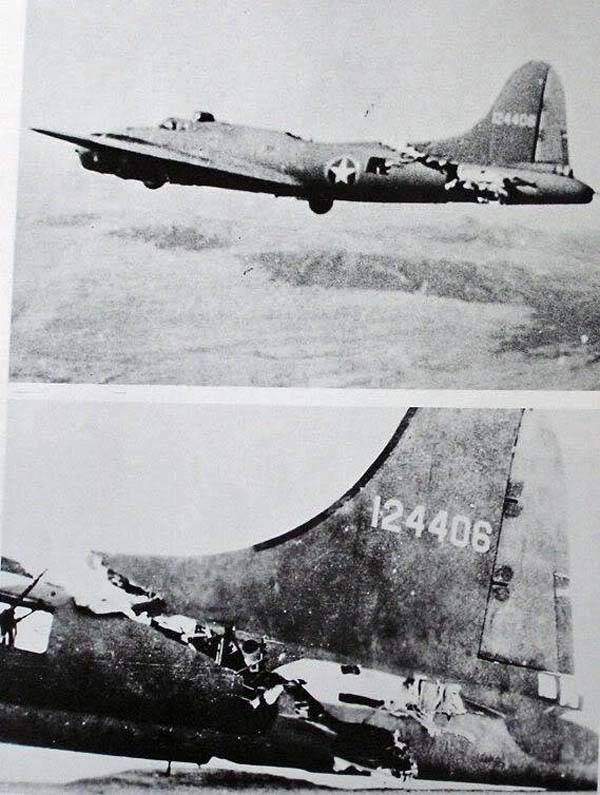 |
Stories often get either misleading with age, or become
expanded in the telling. The original version that I received a long while ago
gave the plane bombing Tunis and then returning to England!! As was pointed out
to me only recently it must have had one hell of a big fuel tank and a speed in
excess of Mach 2!! Hopefully the above version is now much nearer the truth. I
also was pointed in the direction of the pilots own version of events are told
by a relative of a member of the original crew. I wrote to a forum concerned and
asked for permission to use the item, they deigned not to reply so here it is:
The All American’s
Final Mission - The pilot of this
now-famous B-17 recalls her last flight
The All American (124406) was on a mission to Bizerta, Tunisia on February
1st 1943. It was classified as a routine mission against Rommel’s force – some
called it a “milk run”.
The enemy fighters attacked at 1350 on a clear almost cloudless day. The All
American was in tight formation with the other bombers, flying at 28,000 feet.
The enemy aircraft made their passes at the 17’s while anti aircraft fire
belched skyward.
The bombers located the target (the wharf area of Bizerta) and the bombardiers
dropped the bombs. With the bomb bays empty, the aircraft started home.
Kendrick R. Bragg, Jr. was the pilot of the All American and recalls what
happened after leaving Bizerta. “As we left the target and headed home, the
fast enemy ME-109’s once more rose to pounce on us. Suddenly I noticed two of
them far to the north sneaking along in the same direction that we were going.
They were out of range and harmless for the moment, but I told our gunners to
keep an eye on them. “We were flying Number 2 position off the right wind of
the lead plane piloted by Captain Coulter. He, too, had seen the two fighter
planes and I saw his top turret swing around toward the nose to protect the
plane’s most vulnerable quarter.
“I scanned the skies, then looked again at the two enemy craft. They had
suddenly turned and were racing toward us. The two small specks increased
rapidly in size as they came nearer. Evidently they were planning a frontal
attack, determined to shoot it out nose to nose. This was the most difficult
kind of attack but was the surest way of sending a Fortress down.
“On they came, one plane about thirty seconds behind the other. They were ready
for a one-two punch with their terrific firing power. We were flying in tight
formation now with Captain Coulter. He began a slight dive to avoid the
oncoming fighter, and I followed. They patterned us, managing to stay about
level with us. In a split second they were in shooting range and our forward
gunners opened fire. Brilliant tracer bullets flew in both directions, as
though a score of boys were fighting it out with Roman candles.
“The first attacker half-rolled into inverted flight to make a quick get-away.
As he did I saw Captain Coulter’s bomber burst into smoke and start earthward
in an uncontrolled spiral. The second enemy fighter was now our primary
concern. As she followed her leader into a roll our gunners found the mark.
Fifty-caliber bullets ripped into the pilot’s cockpit. The Nazi pilot was
disposed of, but the plane streaked on toward us. I rammed the stick forward in
a violent attempt to avoid collision. The rate of closure of the two planes was
close to 600 miles-an-jour and my action seemed sluggish. I flinched as the
fighter passed inches over my head and then I felt a slight thud like a coughing
engine.

“I checked the engines and the controls. The trim tabs were not working. I
tried to level the All American but she insisted on climbing. It was only with
the pressure from knees and hands that I was able to hold her in anything like a
straight line. The co-pilot tired his controls. He got the same reaction. But
we found by throttling back the engines we could keep her on a fairly even keel.
I tired to call the pilot of the lead plane which had gone down only a moment
before. There was no answer.
“Pilot from top-turret” came an excited voice over the intercom. I was busy
with the controls. “Come in top-turret. What’s the matter with you”? I asked.
“Sir we’ve received some damage in the tail section. I think you should have a
look.”
“We were at 12,000 feet now and no longer needed our oxygen masks. I turned the
controls over to the co-pilot and went toward the rear of the plane. As I opened
the door of the radio compartment and looked back into the fuselage I was
stunned. A torn mass of shredded metal greeted my eyes. Wires were dangling
and sheets of metal were flapping as the air rushed in through the torn
wreckage. Three-fourths of the plane had been cut completely through by the
enemy fighter and a large piece of the ME-109’s wing was lodged in the tail of
our plane.
“The opening made by the German fighter was larger than the exit door. It left
our tail section hanging on by a few slender spars an a narrow strip of metallic
skin. Lieutenant Bragg climbed into the upper turret to assess the damage from
the outside and discovered that the tail section was swinging as much as a foot
and a half out of line with the front of the plane. To make matters worse, the
left horizontal stabilizer was missing, explaining why the airplane was so
difficult to handle.
Bragg decided to try and make it back to Biskra. He returned to the seat,
ordered everyone to an emergency exit, then began the long journey home. He
recalls their arrival: “As we neared the field we fired three emergency flares,
then circled at 2,000 feet while the other planes cleared the runways. We could
see the alert crews, ambulances, and crash trucks making ready for us.
“Without radio contact with the field we had to wait for the signal that all was
clear and ready for us. When we got the signal I lowered the landing gear and
flaps to test the reaction of the All American. They seemed to go reasonably
well, considering. We had two alternatives. We could attempt a landing or we
could bail out over the field and let the plane fly alone until she crashed –
always a dangerous thing to do. I had made up my mind to set her down. She had
brought us safely through so far; I knew she would complete the mission. The
crew decided to ride her down too.
“A green flare from the field signaled that all was clear for our attempt at
landing. I made a long, careful approach to the strip with the partial power
until the front wheels touched the leveled earth. As I cut the throttles, I
eased the stick forward to hold the tail section high until it eased down of its
own weight as we lost speed. “The tail touched the earth and I could feel the grating as she dragged
without tail wheel along the desert sands. She came to a stop and I ordered the
co-pilot to cut the engines. We were home.”
My humble thanks to Robin Clay for bring this to my
attention. I appreciate it.
B-17's Bloody Nose
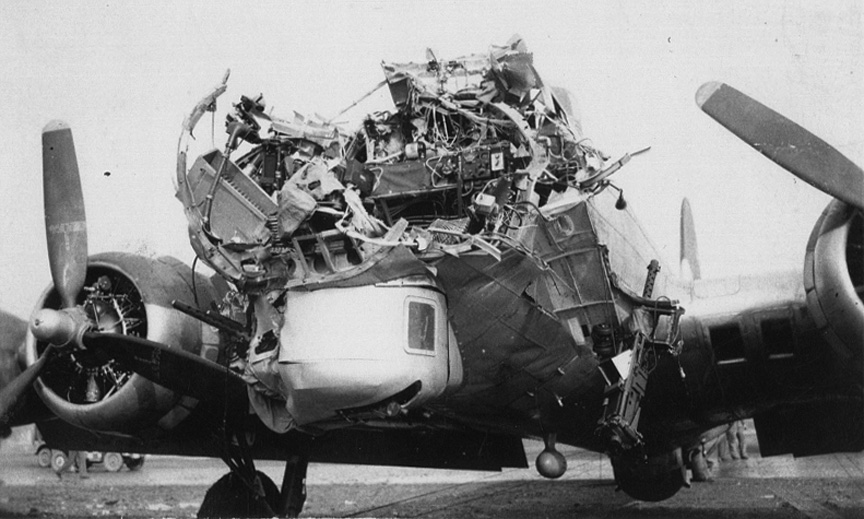
By Allen Ostrom
They could hear it before they could see it! Not all that unusual in those
days as the personnel at Station 131 gathered around the tower and
scattered hardstands to await the return of the B-17s sent out earlier
that morning.First
comes the far off rumble and drone of the Cyclones. Then a spec on
the East Anglia horizon. Soon a small cluster indicating the lead
squadron. Finally, the group.
Then the counting. 1-2-3-4-5. But
that would have been normal. Today was different! It was too early for the
group to return. "They're 20 minutes early. Can't be the 398th." They
could hear it before they could see it! Something was coming home. But
what?
All eyes turned toward the northeast, aligning with the main
runway, each ground guy and stood-down airman straining to make out this
"wail of a Banshee," as one called it. Not like a single B-17 with its
characteristic deep roar of the engines blended with four thrashing
propellers. This was a howl! Like a powerful wind blowing into a huge
whistle. Then it came into view. It WAS a B-17! Low and pointing her nose
at the 6,000 foot runway, it appeared for all the world to be crawling
toward the earth, screaming in protest. No need for the red flares. All
who saw this Fort knew there was death aboard.
"Look at that nose!"
they said as all eyes stared in amazement as this single, shattered
remnant of a once beautiful airplane glided in for an unrealistic "hot"
landing. She took all the runway as the "Banshee" noise finally abated,
and came to an inglorious stop in the mud just beyond the concrete runway.
Men and machines raced to the now silent and lonely aircraft. The
ambulance and medical staff were there first. The fire truck....ground and
air personnel... .jeeps, truck, bikes. Out came one of the crew members
from the waist door, then another. Strangely quiet. The scene was almost
weird. Men stood by as if in shock, not knowing whether to sing or cry.
Either would have been acceptable.
The medics quietly made their
way to the nose by way of the waist door as the remainder of the crew
began exiting.. And to answer the obvious question, "what happened?" "What
happened?" was easy to see. The nose was a scene of utter destruction. It
was as though some giant aerial can opener had peeled the nose like an
orange, relocating shreds of metal, Plexiglas, wires and tubes on the
cockpit windshield and even up to the top turret. The left cheek gun hung
limp, like a broken arm. One man pointed to the crease in chin turret. No
mistaking that mark! A German 88 anti-aircraft shell had exploded in the
lap of the togglier. This would be George Abbott of Mt. Lebanon, PA. He
had been a waist gunner before training to take over the bombardier's
role.
Still in the cockpit, physically and emotionally exhausted,
were pilot Larry deLancey and co-pilot Phil Stahlman. Navigator Ray
LeDoux finally tapped deLancey on the shoulder and suggested they get out.
Engineer turret gunner Ben Ruckel already had made his way to the waist
was exiting along with radio operator Wendell Reed, ball turret gunner Al
Albro, waist gunner Russell Lachman and tail gunner Herbert Guild.
Stahlman was flying his last scheduled mission as a replacement for
regular co-pilot, Grady Cumbie. The latter had been hospitalized the day
before with an ear problem.. Lachman was also a "sub," filling in for
Abbott in the waist.
DeLancey made it as far as the end of the
runway, where he sat down with knees drawn up, arms crossed and head down.
The ordeal was over, and now the drama was beginning a mental re-play.
Then a strange scene took place. Group CO Col. Frank P. Hunter had arrived
after viewing the landing from the tower and was about to approach
deLancey. He was physically restrained by flight surgeon Dr. Robert Sweet.
"Colonel, that young man doesn't want to talk now. When he is ready you
can talk to him, but for now leave him alone." Sweet handed pills out to
each crew member and told them to go to their huts and sleep. No
dramatics, no cameras, no interviews. The crew would depart the next day
for "flak leave" to shake off the stress. And then be expected back early
in November. (Just in time to resume "normal" activities on a mission to
Merseburg!)
Mission No. 98 from North Hampstead had begun at 0400
that morning of October 15, 1944. It would be Cologne (again), led by CA
pilots Robert Templeman of the 602nd, Frank Schofield of the 601st and
Charles Khourie of the 603rd. Tragedy and death appeared quickly and early
that day. Templeman and pilot Bill Scott got the 602nd off at the
scheduled 0630 hour, but at approximately 0645 Khouri and pilot Bill
Meyran and their entire crew crashed on takeoff in the town of Anstey .
All were killed. Schofield and Harold Stallcup followed successfully with
the 601st, with deLancey flying on their left wing in the lead element.
The ride to the target was routine, until the flak started becoming
"unroutinely" accurate.
"We were going through heavy flak on the
bomb run," remembered deLancey. "I felt the plane begin to lift as the
bombs were dropped, then all of a sudden we were rocked by a violent
explosion. My first thought - 'a bomb exploded in the bomb bay' - was
immediately discarded as the top of the nose section peeled back over the
cockpit blocking the forward view." It seemed like the whole world
exploded in front of us," added Stahlman. "The instrument panel all but
disintegrated and layers of quilted batting exploded in a million pieces.
It was like a momentary snowstorm in the cockpit."
It had been a
direct hit in the nose. Killed instantly was the togglier, Abbott.
Navigator LeDoux, only three feet behind Abbott, was knocked unconscious
for a moment, but was miraculously was alive. Although stunned and
bleeding, LeDoux made his way to the cockpit to find the two pilots
struggling to maintain control of an airplane that by all rights should
have been in its death plunge. LeDoux said there was nothing anyone could
do for Abbott, while Ruckel opened the door to the bomb bay and signaled
to the four crewman in the radio room that all was OK - for the time
being. The blast had torn away the top and much of the sides of the nose.
Depositing enough of the metal on the windshield to make it difficult for
either of the pilots to see. "The instrument panel was torn loose and all
the flight instruments were inoperative with the exception of the magnetic
compass mounted in the panel above the windshield And its accuracy was
questionable. The radio and intercom were gone, the oxygen lines broken,
and there was a ruptured hydraulic line under my rudder pedals," said
deLancey.
All this complicated by the sub-zero temperature at
27,000 feet blasting into the cockpit. "It was apparent that the damage
was severe enough that we could not continue to fly in formation or at
high altitude. My first concern was to avoid the other aircraft in the
formation, and to get clear of the other planes in case we had to bail
out. We eased out of formation, and at the same time removed our oxygen
masks as they were collapsing on our faces as the tanks were empty." At
this point the formation continued on its prescribed course for home - a
long, slow turn southeast of Cologne and finally westward.
DeLancey
and Stahlman turned left, descending rapidly and hoping, they were heading
west.. (And also, not into the gun sights of German fighters.) Without
maps and navigation aids, they had difficulty getting a fix. By this time
they were down to 2,000 feet. "We finally agreed that we were
over Belgium and were flying in a southwesterly direction," said the
pilot.
"About this time a pair of P-51s showed up and
flew a loose formation on us across Belgium .
I often wondered what they thought as they looked at the mess up front."
We hit the coast right along the Belgium-Holland border, a bit farther
north than we had estimated Ray said we were just south of Walcheren
Island ."
Still in an area of ground fighting, the plane received
some small arms fire. This gesture was returned in kind by Albro, shooting
from one of the waist guns. "We might have tried for one of the airfields
in France ,
but having no maps this also was questionable. Besides, the controls and
engines seemed to be OK, so I made the decision to try for home." Once
over England ,
LeDoux soon picked up landmarks and gave me course corrections taking us
directly to North Hampstead. It
was just a great bit of navigation. Ray just stood there on the flight
deck and gave us the headings from memory."
Nearing the field,
Stahlman let the landing gear down. That was an assurance. But a check of
the hydraulic pump sent another spray of oil to the cockpit floor.
Probably no brakes! Nevertheless, a flare from Ruckel's pistol had to
announce the "ready or not" landing. No "downwind leg" and "final
approach" this time. Straight in! "The landing was strictly by guess and
feel," said DeLancey. "Without instruments, I suspect I came in a little
hot. Also, I had to lean to the left to see straight ahead. The landing
was satisfactory, and I had sufficient braking to slow the plane down
some. However, as I neared the taxiway, I could feel the brakes getting
'soft'. I felt that losing control and blocking the taxiway would cause
more problems than leaving the plane at the end of the runway." That
consideration was for the rest of the group. Soon three squadrons of B-17s
would be returning, and they didn't need a derelict airplane blocking the
way to their respective hardstands.
Stahlman, supremely thankful
that his career with the 398th had come to an end, soon returned home and
in due course became a captain with Eastern Airlines. Retired in 1984,
Stahlman said his final Eastern flight "was a bit more routine" than the
one 40 years before. DeLancey and LeDoux received decorations on December
11, 1944 for their parts in the October 15 drama. DeLancey was awarded the
Silver Star for his "miraculous feat of flying skill and ability" on
behalf of General Doolittle , CO of the Eighth Air Force. LeDoux for his
"extraordinary navigation skill", received the Distinguished Flying Cross.
The following DeLancey 1944 article was transcribed from the 398th
BG Historical Microfilm. Note: due to wartime security, Northampstead is
not mentioned, and the route DeLancey flew home is referred to in general
terms.
TO: STARS AND STRIPES FOR GENERAL RELEASE
AN EIGHTH
AIR FORCE BOMBER STATION, ENGLAND - After literally losing the nose of his
B-17 Flying Fortress as the result of a direct hit by flak
over Cologne, Germany, on October 15, 1944, 1st Lt. Lawrence M. DeLancey,
25, of Corvallis, Oregon, returned to England and landed the crew safely
at his home base. Each man walked away from the plane except the togglier,
Staff Sergeant George E. Abbott, Mt.
Lebanon, Pennsylvania, who was
killed instantly when the flak struck. It was only the combined skill and
teamwork of Lt. DeLancey and 2nd Lt. Raymond J. LeDoux, of Mt.
Angel, Oregon, navigator, that
enabled the plane and crew to return safely.
"Just after we dropped
our bombs and started to turn away from the target," Lt. DeLancey
explained, "a flak burst hit directly in the nose and blew practically the
entire nose section to threads. Part of the nose peeled back and
obstructed my vision and that of my co-pilot, 1st Lt. Phillip H. Stahlman
of Shippenville, Pennsylvania.
What little there was left in front of me looked like a scrap heap. The
wind was rushing through. Our feet were exposed to the open air at nearly
30,000 feet above the ground the temperature was unbearable.
"There
we were in a heavily defended flak area with no nose, and practically no
instruments. The instrument panel was bent toward me as the result of the
impact. My altimeter and magnetic compass were about the only instruments
still operating and I couldn't depend on their accuracy too well.
Naturally I headed for home immediately. The hit which had killed S/Sgt.
Abbott also knocked Lt. LeDoux back in the catwalk (just below where I was
sitting). Our oxygen system also was out so I descended to a safe
altitude.
"Lt. LeDoux who had lost all his instruments and maps in
the nose did a superb piece of navigating to even find England ..."
During the route home flak again was encountered but due to evasive
action Lt. DeLancey was able to return to friendly territory. Lt.. LeDoux
navigated the ship directly to his home field.
Although the plane
was off balance without any nose section, without any brakes (there was no
hydraulic pressure left), and with obstructed vision, Lt. deLancey made a
beautiful landing to the complete amazement of all personnel at this field
who still are wondering how the feat was accomplished.
The other
members of the crew include:
1. Technical Sergeant
Benjamin H. Ruckel, Roscoe, California, engineer top turret gunner;
2. Technical Sergeant Wendell A. Reed, Shelby, Michigan, radio operator
gunner;
3. Technical Sergeant Russell A. Lachman,
Rockport, Mass., waist gunner;
4. Staff Sergeant Albert
Albro, Antioc h, California, ball turret gunner
5. Staff Sergeant
Herbert D. Guild, Bronx, New York, tail gunner.
Piggy Back Ride
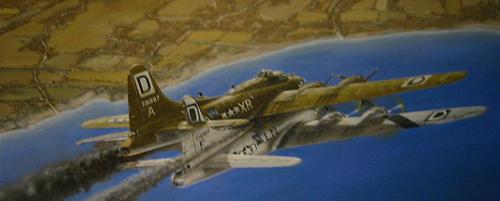
In 2003 they
laid the remains of Glenn Rojohn to rest in the Peace Lutheran Cemetery in
the little town of Greenock, Pa., just southeast of Pittsburgh. He was 81,
and had been in the air conditioning and plumbing business in nearby
McKeesport. If you had seen him on the street he would probably have
looked to you like so many other graying, bespectacled old World War II
veterans whose names appear so often now on obituary pages.
But
like so many of them, though he seldom talked about it, he could have told
you one hell of a story. He won the Air Medal, the Distinguished Flying
Cross and the Purple Heart all in one fell swoop in the skies over Germany
on December 31, 1944. Fell swoop indeed.
Capt.
Glenn Rojohn, of the 8th Air Force's 100th Bomb Group was flying his B-17G
Flying Fortress bomber on a raid over Hamburg. His formation had braved
heavy flak to drop their bombs, then turned 180 degrees to head out over
the North Sea. They had finally turned northwest, headed back to England,
when they were jumped by German fighters at 22,000 feet. The Messerschmitt
Me-109s pressed their attack so closely that Capt. Rojohn could see the
faces of the German pilots. He and other pilots fought to remain in
formation so they could use each other's guns to defend the group. Rojohn
saw a B-17 ahead of him burst into flames and slide sickeningly toward the
earth. He gunned his ship forward to fill in the gap. He felt a huge
impact. The big bomber shuddered, felt suddenly very heavy and began
losing altitude. Rojohn grasped almost immediately that he had collided
with another plane. A B-17 below him, piloted by Lt. William G. McNab, had
slammed the top of its fuselage into the bottom of Rojohns. The top
turret gun of McNabs plane was now locked in the belly of Rojohns plane
and the ball turret in the belly of Rojohns had smashed through the top of
McNabs. The two bombers were almost perfectly aligned at the tail of the
lower plane was slightly to the left of Rojohns tailpiece. They were stuck
together, as a crewman later recalled, like mating dragon flies.
Three of the engines on the bottom plane were still running, as were all
four of Rojohns. The fourth engine on the lower bomber was on fire and the
flames were spreding to the rest of the aircraft. The two were losing
altitude quickly. Rojohn tried several times to gun his engines and break
free of the other plane. The two were inextricably locked together.
Fearing a fire, Rojohn cut his engines and rang the bailout bell. For his
crew to have any chance of parachuting, he had to keep the plane under
control somehow.
The
ball turret, hanging below the belly of the B-17, was considered by many
to be a death trap the worst station on the bomber. In this case, both
ball turrets figured in a swift and terrible drama of life and death.
Staff Sgt. Edward L. Woodall, Jr., in the ball turret of the lower bomber
had felt the impact of the collision above him and saw shards of metal
drop past him. Worse, he realized both electrical and hydraulic power was
gone.
Remembering escape drills, he grabbed the handcrank, released
the clutch and cranked the turret and its guns until they were straight
down, then turned and climbed out the back of the turret up ino the
fuselage. Once inside the planes belly Woodall saw a chilling sight, the
ball turret of the other bomber protruding through the top of the
fuselage. In that turret, hopelessly trapped, was Staff Sgt. Joseph Russo.
Several crew members of Rojohns plane tried frantically to crank Russos
turret around so he could escape, but, jammed into the fuselage of the
lower plane, it would not budge. Perhaps unaware that his voice was going
out over the intercom of his plane, Sgt. Russo began reciting his Hail
Marys.
Up in the cockpit, Capt. Rojohn and his co-pilot 2nd Lt.
William G. Leek, Jr., had propped their feet against the instrument panel
so they could pull back on their controls with all their strength, trying
to prevent their plane from going into a spinning dive that would prevent
the crew from jumping out. Capt. Rojohn motioned left and the two managed
to wheel the huge, collision-born hybrid of a plane back toward the German
coast. Leek felt like he was intruding on Sgt. Russo as his prayers
crackled over the radio, so he pulled off his flying helmet with its
earphones.
Rojohn,
immediately grasping that crew could not exit from the bottom of his
plane, ordered his top turret gunner and his radio operator, Tech Sgts.
Orville Elkin and Edward G. Neuhaus to make their way to the back of the
fuselage and out the waist door on the left behind the wing. Then he got
his navigator, 2nd Lt. Robert Washington, and his bombardier, Sgt. James
Shirley to follow them. As Rojohn and Leek somehow held the plane steady,
these four men, as well as waist gunner, Sgt. Roy Little, and tail gunner,
Staff Sgt. Francis Chase, were able to bail out.
Now the plane
locked below them was aflame. Fire poured over Rojohns left wing. He could
feel the heat from the plane below and hear the sound of .50 machinegun
ammunition cooking off in the flames. Capt. Rojohn ordered Lieut. Leek to
bail out. Leek knew that without him helping keep the controls back, the
plane would drop in a flaming spiral and the centrifugal force would
prevent Rojohn from bailing out. He refused the order.
Meanwhile,
German soldiers and civilians on the ground that afternoon looked up in
wonder. Some of them thought they were seeing a new Allied secret weapon a
strange eight-engined double bomber. But anti-aircraft gunners on the
North Sea coastal island of Wangeroge had seen the collision. A German
battery captain wrote in his logbook at 12:47 p.m.:
Two
fortresses collided in a formation in the NE. The planes flew hooked
together and flew 20 miles south. The two planes were unable to fight
anymore. The crash could be awaited so I stopped the firing at these two
planes.
Suspended in his parachute in the cold December sky,
Bob Washington watched with deadly fascination as the mated bombers,
trailing black smoke, fell to earth about three miles away, their downward
trip ending in an ugly boiling blossom of fire.
In the cockpit
Rojohn and Leek held grimly to the controls trying to ride a falling rock.
Leek tersely recalled, The ground came up faster and faster. Praying was
allowed. We gave it one last effort and slammed into the ground. The McNab
plane on the bottom exploded, vaulting the other B-17 upward and forward.
It slammed back to the ground, sliding along until its left wing slammed
through a wooden building and the smoldering mess came to a stop. Rojohn
and Leek were still seated in their cockpit. The nose of the plane was
relatively intact, but everything from the B-17 massive wings back was
destroyed. They looked at each other incredulously. Neither was badly
injured.
Movies have nothing on reality. Still perhaps in shock,
Leek crawled out through a huge hole behind the cockpit, felt for the
familiar pack in his uniform pocket pulled out a cigarette. He placed it
in his mouth and was about to light it. Then he noticed a young German
soldier pointing a rifle at him. The soldier looked scared and annoyed. He
grabbed the cigarette out of Leaks mouth and pointed down to the gasoline
pouring out over the wing from a ruptured fuel tank.
Two of the six
men who parachuted from Rojohns plane did not survive the jump. But the
other four and, amazingly, four men from the other bomber, including ball
turret gunner Woodall, survived. All were taken prisoner. Several of them
were interrogated at length by the Germans until they were satisfied that
what had crashed was not a new American secret weapon.
Rojohn,
typically, didn't talk much about his Distinguished Flying Cross. Of Leek,
he said, in all fairness to my co-pilot, he's the reason I'm alive today.
Like so many veterans, Rojohn got unsentimentally back to life after
the war, marrying and raising a son and daughter. For many years, though,
he tried to link back up with Leek, going through government records to
try to track him down. It took him 40 years, but in 1986, he found the
number of Leeks mother, in Washington State. Yes, her son Bill was
visiting from California. Would Rojohn like to speak with him? Some things
are better left unsaid. One can imagine that first conversation between
the two men who had shared that wild ride in the cockpit of a B-17. A year
later, the two were re-united at a reunion of the 100th Bomb Group in Long
Beach, Calif. Bill Leek died the following year.
Glenn Rojohn was
the last survivor of the remarkable piggyback flight. He was like
thousands upon thousands of men, soda jerks and lumberjacks, teachers and
dentists, students and lawyers and service station attendants and store
clerks and farm boys who in the prime of their lives went to war.
The Airman Who Wouldn't Give Up |
![]()

